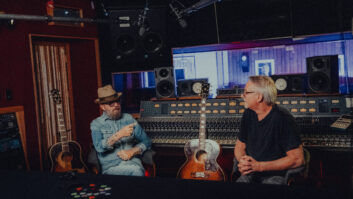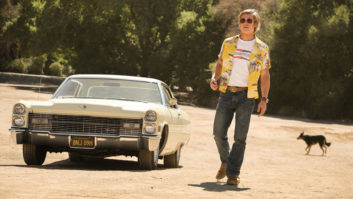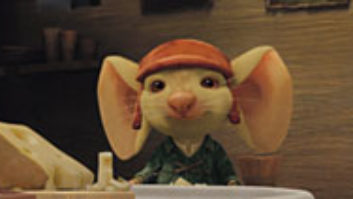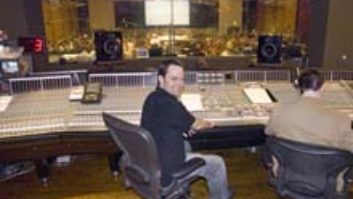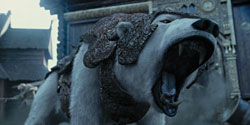
Photo: Copyright 2007 Laurie Sparham/New Line Cinema
These are great times for fantasy films. CG technology has gotten to the point where almost anything can be realistically depicted onscreen, so the floodgates have opened and one popular fantasy book after another is finding its way to the big screen. Hot on the heels of the already immensely successful The Lord of the Rings and Harry Potter series have come The Chronicles of Narnia (The Lion, the Witch and the Wardrobe was a surprise smash; the second film is on the way) and now New Line’s The Golden Compass, adapted from the first book in Philip Pullman’s popular His Dark Materials trilogy.
The plot is much too complex to recount here, but it involves a magical compass device that has the power to reveal the truth, a young girl’s search for friends who have been kidnapped by mysterious beings known as Gobblers, a snowy world with giant talking polar bears and a mysterious substance known as Dust. The film — directed by Chris Weitz (About a Boy, American Dreamz), and starring Nicole Kidman, Daniel Craig, Sam Elliott and Dakota Blue Richards — proved to be a tremendously challenging undertaking for everyone involved, including the superb British film audio team spearheaded by sound designer and supervising sound editor Glenn Freemantle.
When we spoke at the beginning of November, just a month before the $150 million film’s worldwide release, Freemantle and the rest of the audio post crew were in the last throes of final mixing at De Lane Lea Studios in London. Mike Prestwood Smith was handling the dialog and music mixing and Mark Taylor the effects; their previous work together includes Harry Potter and the Order of the Phoenix and Casino Royale. The score is by French composer Alexandre Desplat.

The Golden Compass’ sound design and mix crew, from left: Mike Prestwood Smith, Glenn Freemantle, Hugo Adams, Niv Adiri, Tom Sayers and Mark Taylor
“We’ve been in three theaters really,” Freemantle offers during a break in the final. “We premixed the dialog down at Peter Gabriel’s studio, Real World — Mike [Prestwood Smith] turned it into a film mixing suite; it was all mixed inside Pro Tools. Then we were up at Pinewood [Studios] doing the effects premixing. We basically hard-premixed six or seven of the atmospheres [ambiences] there and also hard-premixed the hard-cut effects, like doors and things that would not move [in the mix]. Now we’ve been here at De Lane Lea quite a while, adding things and finishing up.
“All the design on the ships and the battles and the bears and everything we kept live in Pro Tools so we could change them,” he continues. “That’s been very handy, too, because when the music comes in and you see what frequencies are in there, sometimes you have to adjust [the FX] if you want to keep the same level of detail. So we have a plethora of Pro Tools 7.3 in the back running all these sessions — five or six effects machines running live, plus the dialog and the music machines. It looks like NASA rather than a mixing stage right now, but it’s all running smoothly.” Both the mix room at De Lane Lea and the one at Pinewood are equipped with Neve DFC Gemini consoles.
Freemantle grew up in a film tech world: His father, Brian Freemantle, was an editor on numerous British TV series and programs. Glenn Freemantle decided to go the sound route and got his start in the early ’80s, first working as an assistant dubbing editor under Jim Shields on Yentl. By the late ’80s, he’d branched into FX editing and Foley, and by 1991 he was supervising while also occasionally still working as a dubbing editor, sound designer or in other capacities. Among the many films he’s supervised in the past decade are Spice World, Wing Commander, Mansfield Park, Bridget Jones’ Diary (and the sequel), 28 Days Later (and its sequel), Love Actually, Nanny McPhee, Sunshine and V for Vendetta (for which he was also lead sound designer).
Freemantle has been working on The Golden Compass on and off for nearly two years: “We were in on the proof-of-concept the Christmas before last to get the film green-lit,” he continues. “We saw all the ideas and the graphics of what it was going to be like and I had a book of all the concept art, which showed what all these things were going to look like — the airship and the bears, everything. They were all quite fantastic, and so already we were talking about sound and how we could re-create these worlds.” Freemantle also read Pullman’s book “to see what his original approach was and perhaps incorporate some of them with the filmmaker’s ideas. But I think in general you get a lot more out of it if you go into a film with an open mind rather than having too many preconceived ideas, because that limits your field of thought processes.”
Because of the heavy reliance on CG backgrounds and visual FX, much of The Golden Compass was shot on soundstages at Pinewood in front of green screens, so the sound crew had to base much of their work on detailed renderings of places and creatures, fine-tuning as CG shots became available. “You start with nothing and you have to create a world,” Freemantle says. “The visuals are so great nowadays, the sound has to match the quality of the images so you can really sell the reality of the scene.” Production dialog was captured by Tony Dawe, but as anticipated, much of that was redone in post because of so much noise from wind machines and such. Lee Herrick was ADR supervisor, while Gillian Dodders was the primary dialog editor.
Stiff challenges for the sound crew emerged with the very first scene. “The story starts at this Oxford-type of place that looks like it’s in the past a bit,” Freemantle explains. “It’s very regal, very grand, with rich, beautiful colors, so you have to treat it like a classic to get that richness of the picture in the sound. Then all of a sudden these airships and this car are in this world, so you have a really big contrast of these grand, old buildings and this sky ferry that looks like a zeppelin but has ‘anabaric’ power, and it’s sort of futuristic — all gold and red. The [sky ferries] have these things inside them that are like gyroscopes that spin, spin, spin, and to create that whirling gyroscopic sound we shot lots of blades and metal and dopplered them at different speeds. Inside of [the gyroscopes] is their power source, which is blue and moves ’round in a weird way, and for that we combined lots of water samples through various doppler speeds at all different times, with some electric [sounds] so you get this big swishing that’s part electrical but it’s made from water, and there’s lots of variance.” Then, to give the sound of the airships themselves more weight, Freemantle says they used a lot of slowed-down sounds, bass and exaggerated air movements, “so that when this thing comes by your house, it just sounds massive.”
Another magical marvel in the film that required considerable sonic creativity was the alethiometer, or Golden Compass, which possesses both a watch-like mechanical physicality and a more abstract psychological/spiritual dimension. The power of the alethiometer and the struggle to both possess it and learn its secrets are central to the story. To capture the Compass’ enigmatic quality, Freemantle and his team used the high, singing tones of Tibetan prayer bowls as a base sound. “We shot loads of Tibetan bowls and also glass bowls — we had all these different high and low pitches,” he says. “The alethiometer sort of sings to [Lyra, the young female protagonist] when she holds it. We put the bowls on different metal surfaces so they’d resonate and give these weird sounds, so when something bad would be [revealed] in the compass, you’d start off with this pure humming and then it would change and distort so it would sound more dangerous. The idea was these sounds would resonate in and then sort of take you into the compass. Also, Alexandre’s music would tune the alethiometer into the music so we got crossover.

Dakota Blue Richards as Lyra, who is given the alethiometer.
Photo: Copyright 2007 Laurie Sparham/New Line Cinema
“From those tones, you then go into the alethiometer and you find the Dust so there’s all this movement of Dust particles,” Freemantle continues. “We used all sorts of organic sounds inside there, like rainsticks, wind, water, fire, breath; even NASA sonifications we got hold of, which are literally sounds from space, from out in the universe. Then we used granular synthesis [plug-ins], which takes the different elements and makes sort of sound clouds out of it — it takes each one of these sounds and splits them up into little pieces of [sound]; they become tiny, different frequencies. Then we panned them around the screen in 5.1. So it all starts with all these beautiful tonal sounds that resonate, and then you fly through it and you have all these organic sounds that then turn into these tiny little particles, as it were. It flows and it swirls and goes around the surrounds. It’s quite effective.”
If you’ve seen previews and commercials for The Golden Compass, no doubt you’ve seen the gargantuan bears, Iorick and Ragnar by name. “Iorick’s voice is Ian McKellan and obviously that had to be beefed up to fit the size of the bear,” Freemantle says. What — messing with the performance of the great Sir Ian? “Well, beefed up but keeping the integrity of his voice — that was paramount,” he clarifies. “It had to sound big, but we didn’t want it to sound like a monster, and we also didn’t want it to sound like it was overprocessed or overtreated. So basically what we did with Iorick is put it through an Eventide [Harmonizer] and pitched it slightly and added bass to it. We were able to give him a bigger chest and a resonance, and then, of course, we also added various bear noises to that. The idea, which we worked on very hard, was to get his voice and the bear noises very close in register so it could come out growling and breathing and then have it go into his voice and you didn’t feel they were two different sources.”
As for the bear sounds, “We got some from natural history sources and other places. We also cheated with some walruses and other things,” Freemantle says. “But we needed heavy breathing and a gurgling growl that would go into a [spoken] line if he was getting cross. Tom Sayers, who is one of the sound designers who works with me — for 13 years now — spent a lot of time feathering these sounds in to make it all work; it’s stunning.” Freemantle also cites his longtime associate Niv Adiri for his invaluable contribution to the sound design and sound editing on the film, and the work of effects editors Ben Barker and Andy Kennedy.
“Then we had to create all the movements of the bear, too. We wanted the bear to have presence so you really felt it. So that meant trying to get as much detail as we could both in the movements and the lip-smacking and teeth-gnashing. What I love is the fine detail — if you can get those, the little sounds will sell it, not just the big sounds.”

Lee Herrick and Gillian Dodders (foreground)
This isn’t to say Freemantle was ever hesitant to “go big” with his sounds. When we first meet Iorick, he lets out a deafening roar, “and we blast it right across every speaker — left, right, left-surround, right-surround, sub — and it makes the whole room rumble,” he says with a laugh. “He stands up and he falls down, and as he lands the whole theater just rocks. From that moment you know this boy means business; he’s got power, he’s got weight.”
Still, Freemantle says that he tries to avoid overusing the sub channel. “You have to choose your moments because otherwise it can sound sort of woolen; it gets muddy. Like today we’ve been working on a battle scene, and it’s very important that we keep a certain clarity in the sound, even though obviously there’s a lot going on in the scene. Otherwise, what you get is a confusing mess.”
Foley for the film was shot at a fourth facility — the studios of Paris Post Production in Joinville-le-Pont — using Freemantle’s favorite Foley artist, Nicolas Becker. The Foley was recorded by Philipe Amouroux and edited by Hugo Adams. “It was a fairly complicated Foley job,” Freemantle says. “We shot a lot of the armor out there for the bear fight, which we then brought back and manipulated [in England] There are three distinct types — Ragnar’s armor, Iorick’s armor and the bear army’s armor. We stacked up [the sounds] like a sandwich with different types of metal and terra-cotta tiles to get the denseness of stone.”

Nicole Kidman stars sa Mrs. Coulter, a scientist and world traveler..
Photo: Copyright 2007 Laurie Sparham/New Line Cinema
Becker also brought a recording rig into the French Alps to capture snow recordings that could be used in scenes depicting the wintry place where the kidnapped children are kept, Bolvangar. “It really made a difference having proper snow stuff,” Freemantle notes. “He shot all different depths and then sweetened them with Foley [back at PPP]. He always does such good work.”
The examples above barely scratch the surface of the sound challenges The Golden Compass presented. In fact, when I initially asked Freemantle about the most challenging scene from his perspective, he immediately deadpanned, “All of them!” There’s nothing simple about painting sonic pictures of places and things that practically defy imagination, while at the same time hitting all the right notes with the conventional demands of sound for film. It requires tremendous imagination, discipline and the concerted efforts of many, many craftspeople.
“When you work on any film,” Freemantle stresses, “it’s never one person; it’s always a team effort and I’m a firm believer in my team. You need everybody to do a great sound job, and in this case they really did. I can’t say enough about them. This one has really been a lot of work — and it’s not over yet,” he chuckles, “but it’s coming out really well. Again, because of the team.”
Blair Jackson is the senior editor of Mix.
